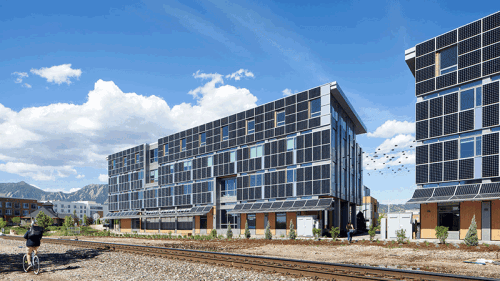Yesterday’s general session titled “Real Estate, Construction, Infrastructure, and Logistics” was delivered by Dr. Parag Khanna, managing partner of FutureMap and author of Connectography: Mapping the Future of Civilization, which forecasts high-growth cities and emerging infrastructures.
“The first thing to point out is that we live in a time of crises,” said Khanna, emphasizing the plural of crisis to denote the pandemic, the war in Ukraine, economic inequality, and other events. “You don’t get to pick your crisis.
“I can’t think of a time in peace in the lifetime of anyone in this room when you had more than a million political refugees from eight different conflicts or countries, different parts of the world simultaneously, right now . . . from seven or eight different conflicts that are bumping into each other producing more than a million displaced people—in some cases, 5, 6, 7 million people at the same time,” Khanna said. “That’s the world we live in.”
That displacement is in addition to displacement within countries due to civil wars, and economic dislocation resulting from industrialization and automation, among other causes.
“Cloud Coders”
In a deeper sense, the crises that affect us as a civilization are also unfolding more slowly, he said, and, in a fundamental way, colliding with each other, and each will in some way also redraw the map of humanity. Various factors like the outsourcing of labor from the Rust Belt states to Asia are shifting populations. Add to that the technological disruption that allows many knowledge workers—called “cloud coders” by Khanna—to work from anywhere, as well as the acceleration of climate change, and it is easy to see and believe in a seismic shift in population centers.
According to Khanna, the countries that the most software developers (a.k.a. “young people”) want to relocate to are, in order: 1) Canada, 2) the United Kingdom, 3) Germany, 4) the Netherlands, 5) Ireland, 6) Spain, 7) the United States, 8) Australia, 9) New Zealand, and 10) Portugal.
Meanwhile, 10 of the 20 best cities for digital nomads—based on internet speed and cost of living—are Buenos Aires, Argentina; Ko Pha Ngang, Thailand; Istanbul, Turkey; Chiang Mai, Thailand; Phuket, Thailand; São Paulo, Brazil; Bangkok, Thailand; Canggu, Indonesia; Bali, Indonesia; and Mexico City.
In contrast with the older generations in wealthy Western countries such as the United States, where the average person may be married with two kids and living in a home they own in the suburbs, young people on average across the globe today tend to be single, childless, and not loyal to their own country when it comes to happiness, Khanna said.
Ongoing Migration
“The net number of people who live outside their own country has steadily risen every year, even though the annual rate of growth and the number of people who have migrated and relocated has continuously expanded, even during COVID,” Khanna said. He said that the data for the past couple of years is “remarkable” and an indication of the human impulse and desire to be in places most suited to an individual’s circumstances.
Human desire aside, where people live is also dictated by which latitudes are considered suitable for human habitation and where agriculture can thrive. Places where temperatures continue to rise become less habitable for human beings.
The current strategy is unsustainable, he said. “All the diplomatic instruments and platforms and public/private partnerships—so much of this is focused on climate mitigation in the real estate industry. Everyone is seeking to move towards net zero building to reduce emissions,” Khanna said. Indeed, he estimates that 95 percent of total climate-related spending is going toward mitigation, including elements like greening supply chains, climate-resistance infrastructure, and renewable energy.
“You should do all of them” he said, but spend 10 times the amount of money to solve the carbon problems, given the already catastrophic effects of climate change and the race against the clock.
According to the speaker’s charts, mitigation includes decarbonization of industry and supply chains (e.g., green cement, cell-based meat), large-scale renewable energy generation, and geoengineering (e.g., reflecting solar radiation, carbon sequestration).
But Khanna is also an advocate of adaptation, which focuses on measures such as climate-proofing (land reform, disaster management, coastal flood protection); reducing urban heat island effects (sustainable building design like biomimicry); movable cities (modular and mobile homes, buildings, and infrastructure); and population resettlement.
Khanna suggests that one solution is incentivizing gradual relocation to geographies that are already removed from the disastrous impacts of climate change like rising sea levels in coastal markets.
Given its latitude, the United States is on the “front lines of climate change” and is doing very little in terms of mitigation, given the need.
Relocation
Encouraging relocation to climate-resilient areas and investing in that infrastructure could create a climate oasis that will draw millennials and generation Z. Not only are these age cohorts not having children or getting married, they also cannot afford to buy homes, the result of which has been a flight to mobile homes. For younger generations, the “American dream” is defined as physical mobility and new communities in which they feel they belong—and that are wired and affordable.
Indeed, Khanna points out that the current generation is the most mobile in human history, a result of influences like economic expansion and globalization. “But at an individual level, it’s simply because they don’t have kids,” he said.
In the end, cities are now competing domestically and internationally to attract the most workers—employing techniques ranging from paying grants to new arrivals to providing tax breaks. “And so cities are the front lines in deciding who wins and who loses,” he said.
The growing awareness of climate risk will make the current top-performing geographies less desirable to live in and invest in. According to Khanna’s research, 80 percent of Americans have experienced a heat wave and 40 percent live in counties that experienced a climate disaster in 2021.
Identifying the next prime geographies using predictive modeling can enable land arbitrage to capture future real estate appreciation and generate higher net operating income, according to Khanna. And understanding the preferences of generations X and Z will help the real estate industry shape new strategies that entail buying and building in “climate oases.”
SIBLEY FLEMING is the editor in chief of Urban Land.
Related: Mapping the Future of a Global, Connected Civilization




